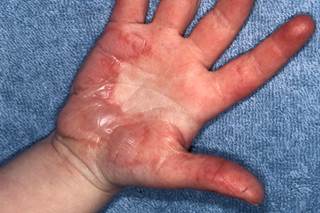The skin, covering an area up to 20 square feet, has 3 layers: the epidermis-the outmost skin, the dermis, the second layer and the hypodermis-the deeper subcutaneous tissue. Partial thickness burn or second degree burn affects the top two layers of skin named as epidermis and hypodermis. Healing occurs with some scarring which usually takes 2 to 3 weeks.
Types of Partial Thickness Burn
Partial thickness burns has two types: A burn involving first layer and some part of the second layer is called as superficial second degree burn. In this case, deeper layers, sweat glands or oil glands are spared. Another type called deep second degree burn, involves damage to the middle layer, sweat glands and oil glands.
Partial thickness burns are serious as there are high risk of infections and other complications. Even after treatment there are chances that they may change with time and evolve into a full thickness burns.
What Are the Signs of Partial Thickness Burn?
Signs of partial thickness burn vary depending upon the layers involved:

- The skin appears moist and painful in both the cases.
- Superficial partial thickness burns are present with red skin that blanches easily when pressure is applied with a finger. Clear blisters are also present.
- Deep partial thickness burns can easily evolve into full thickness or third degree burn. They may cause bloody blisters and present with non-blanching red and white skin.
How to Deal With Partial Thickness Burn
Easing the pain and preventing superimposed infections are the primary goals while treating partial-thickness burns. The kind of treatment depends on the type and cause of burns.
1. For Blisters
Treatment depends whether blisters are open or closed.
- For closed blisters, jewelry and tight clothes should be immediately removed from the burned area before skin swelling starts. It can be done in an emergency room with special tools. The burn should be cleaned with cool running water or cold moist cloth. Use of ice water or ice should be avoided as it can cause further damage to the skin. You should avoid breaking the blisters, as once broken chances of them getting infected increases.
- In case of open blisters, cool water should be used only if its size is small. Running water can increase the risk of shock when flown over a large burn. Clothing shouldn’t be removed in case it’s stuck to the burn.
2. For Chemical Burns
While dealing with chemical burns special care should be taken to avoid any further contact of chemical with the skin.
- Clothing and jewelry of the involved area should be immediately removed. A sterile dry bandage should be tied loosely to cover the area once the entire chemical has been removed.
- For liquid chemical, immediate flushing with running water should be done for minimum 15 min. Care should be taken to avoid any splashing of chemical into the eyes. Once flushed, poison control center should be called for advice regarding the specific chemical that caused the burn. It's of great help if one has the chemical container while making the call to avoid any misinterpretation or giving wrong name of the chemical.
- In case of dry chemical, it is better to brush off the chemical unless a very large amount of water is available to clean, as small amounts of water can trigger a chemical reaction. Avoid neutralizing a chemical e.g. neutralizing skin exposed to acid by using an alkali, as large amount of heat may be produced during the process which can increase the burning.
3. For Electrical Burns
All electrical burns need immediate examination by a health care provider. It may appear as only minor damage, but electrical burns can go deep into the skin, affecting the underlying tissues. As injuries may not become apparent for several hours or till next day, any delay in its management may have serious consequences. Cover the affected area with loosely wrapped clean and dry gauze or bandage. Do not apply any cream or ointment.
4. For All Partial Thickness Burns
- Burn or blister should be left uncovered if there is no chafing or rubbing. If required, a dry, clean, loose gauze can be used to cover the blister to avoid contact with clothing. Any activity or clothes or shoes that can irritate the blisters should be avoided till healing.
- Until advised by healthcare provider, ointments or creams of any kind, e.g. petroleum jelly, grease, home remedies, should not be used as they can interfere with the healing process and enhance the risk of infection.
- A painkiller such as aspirin or ibuprofen helps in relieving pain and inflammation. Due to the risk of Reye's syndrome in children, you should consult your doctor before giving you kid any medicine containing aspirin like Pepto-Bismol, some cold medicines and baby aspirin, etc.
- NSAIDs such as naproxen, ibuprofen and aspirin should not be used for more than 10 days unless recommended by healthcare provider. They have a risk of stomach bleeding and other problems that increase with age. Hence, instruction label should be read carefully before starting the medicines and followed accordingly.
5. Seek Medical Care
Burns more than 2 to 3 inches, especially if it's on face, hand, feet, groin, buttocks or big joints need immediate attention of a healthcare provider. Medical care includes replacing the body fluids lost from the burnt area through veins, antibiotics to prevent burnt and exposed skin from impending infections, painkillers, tetanus shots and regular dressing of the burnt area. Skin grafting can be done later to minimize scarring.
Watch the video to know the causes of burns, like chemical burns, sunburns, heat burns and the like, and first aid tips to take care of your burns on skin, eye mouth, etc.
